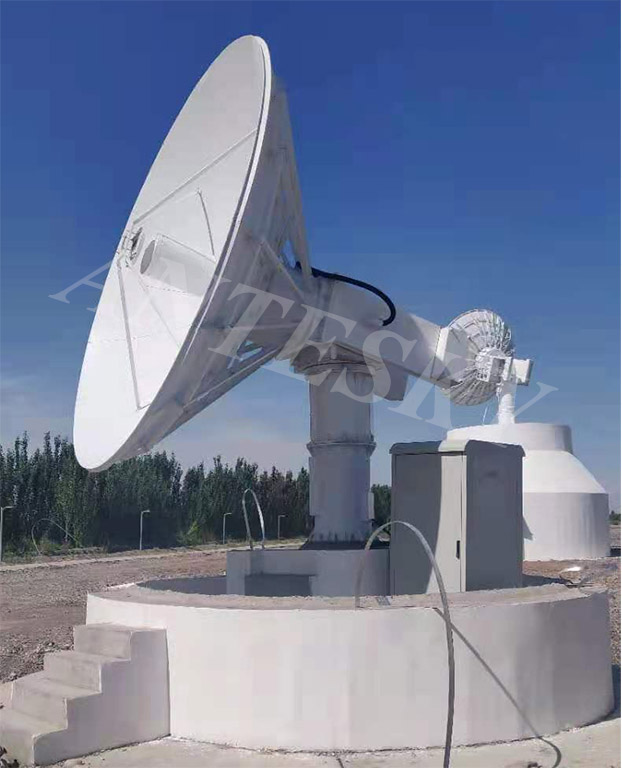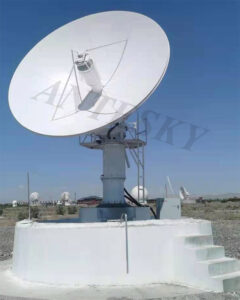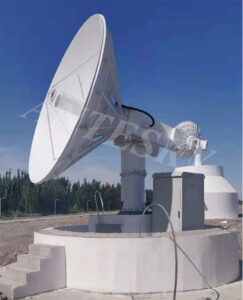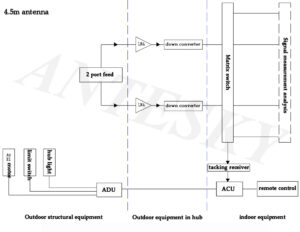
Along with broadcasting and Internet access, satellite communications have transformed the way of global connectivity, enabling seamless communication over long distances. As one of the basic components of the satellite communication system, the satellite antenna is responsible for transmitting and receiving signals to satellites in space.
Previously, we had shipped one set of 7.3M C/KU Dual bands receive only antenna to Europe and the antenna operates well with local network until now. In this article, we will explore the excellent performance and advantages of the newly updated 4.5m C & Ku Dual Band Satellite Antenna.
1. What is satelliteantennas?
Before going into the details of the 4.5m C & Ku dual band satellite antenna, first let us briefly discuss the basics of a satellite antenna. Satellite dishes are parabolic reflectors used to focus and direct electromagnetic signals toward or from specific points in space. The size of an antenna is a key factor affecting its performance, with larger antennas generally providing higher gain and better signal quality.
It has to be said that C&Ku dual-frequency technology is a major improvement in satellite communications. General satellite dishes usually work in a single frequency band, but with dual-band technology, one antenna can now cover both C and Ku bands. The C-band operates in 3.4 to 4.2 GHz, while the Ku-band operates in 10.95 to 12.75 GHz. This dual-band capability ensures flexibility and adaptability to changing communication needs, making these antennas more versatile and cost-effective. Below is the technical specification and diagram of 4.5m C & Ku dual band satellite antenna for reference.
Fig. 1 4.5-meter C/Ku dual-band antenna photo
4.5-meter C/Ku dual-band antenna is composed by antenna structure system, antenna feed system, antenna control system and RF system as shown in Fig. 2.
Fig. 2 Diagram of 4.5m C/Ku band antenna system
Technical specification of 4.5m C/Ku band antenna
| Electrical Specification | ||
| Diameter | 4.5M | |
| Operating Frequency, GHz | C-Band | Ku-Band |
| Receive | Receive | |
| 3.4~4.2 | 10.95~12.75 | |
| Port | 2/4 Port | |
| Gain, Mid-band, dBi | ≥41+20lg(f/4GHz) | ≥51+20lg (f/12.2) |
| Polarization | double circular polarization, left and right rotation can be electrically switched | linear polarization, vertical and horizontal electrical switching |
| Circular polarization axial ratio,dB | ≤0.75 | |
| VSWR | ≤1.5:1 | ≤1.5:1 |
| Antenna system G/T value: | ≥18+20lg(f/4)dB/K (El≥5º, sunny day and breeze) | ≥28.5+20lg(f/12.2 GHz)dB/K (El≥5º, sunny day and breeze) |
| Circular polarization axial ratio | ≤0.75dB | |
| Feed Interface | CPR-229G | WR-75 |
| Radiation Pattern:First Sidelobe | ≤-14dB | ≤-14dB |
| Mechanical Specification | ||
| Antenna Type | Parabolic Antenna | |
| Main reflector diameter | 4.5m | |
| Pedestal type | AZ-EL Semi-turntable/turntable optional | |
| Drive mode | AZ/EL/POL Motorized | |
| Tracking mode | Program tracking, step tracking and manual | |
| Azimuth | 180°±170° continuous | |
| Elevation | 0°~90° continuous | |
| Polarization | ±90° continuous | |
| Max. Rotate speed | AZ≥1º/s; EL≥0.1º/s | |
| Shaft angular position accuracy | ≤0.01° | |
| Power supply | AC 380V±10%; 50Hz
220V±10%; 50Hz |
|
| Servo performance | ||
| Display accuracy | AZ/EL 0.01°, polarization 0.1° | |
| Display range | Azimuth: 0.00°~359.99° ,
Elevation: 0.00°~89.99° |
|
| Working mode | Manual, pointing, position preset, step/program tracking, standby | |
| Pointing accuracy | ≤0.1° | |
| Environmental Specification | ||
| Working temperature | Outdoor: -40℃~+60℃,
Indoor: 0℃~+30℃ |
|
| Wind resistance | Steady wind 20.8m/s, gust 27m/s, normal work
Collection wind speed 35m/s When the wind is 55m/s, the antenna will not be damaged in the locked zenith position |
|
| Relative Humidity | 0%~ 100% | |
| Rain and snow resistance | Rainfall:100mm/h
Snowfall: 60mm thick |
|
Also, Antesky can offer customized dual band or tri-band antennas like 4.2m S/X band X-Y pedestal antenna, 6.2m X/KA band antenna and other dual bands including 11.3m C&L band antenna as per client request.
3. Advantagesof 4.5 meter C & Ku dual-band satellite antenna:
a.WideCoverage Area
One of the primary advantages of a 4.5-meter dual-band antenna is its wide coverage area.
The larger size allows for a broader beamwidth, meaning it can communicate with multiple satellites simultaneously and offer better connectivity across a larger geographic region.
b. Higher Gain and Signal Quality
Larger antennas provide higher gain accordingly, which directly translates to a stronger and more stable signal reception.
This gain boost significantly improves the overall signal quality, leading to better data transfer rates and reduced chances of signal dropouts.
c. Weather Resistance
Due to its larger size than typical fixed stations, the 4.5 meter C & Ku dual-band satellite antenna is better able to resist adverse weather conditions such as rain fade, a phenomenon in which heavy rainfall attenuates satellite signals. This is because the larger surface area allows the antenna to pick up a stronger signal even in bad weather.
4. Common applications 4.5 meter C & Ku dual-band satellite antenna:
a.Telecommunication:
Telecommunication providers use 4.5 meter C & Ku dual-band satellite antenna to establish high-quality voice and data communication links between remote locations, enabling reliable long-distance connectivity.
b.Broadcasting:
The broadcasting industry benefits greatly from the wide coverage and high gain of these antennas.
TV and radio broadcasters rely on them to transmit signals to a broader audience with exceptional clarity and reach.
c. Internet Service Providers (ISPs):
ISPs leverage 4.5-meter dual-band antennas to offer internet access to underserved areas, rural communities, and regions with limited terrestrial infrastructure.
5. Installation and Maintenance of 4.5-meter C & Ku dual-band satellite antenna:
Proper installation and regular maintenance are essential to ensure the optimal performance and longevity of 4.5-meter C & Ku dual-band satellite antenna.
Installation involves precise alignment and calibration to establish an accurate link with the target satellite.
Routine maintenance, including checks for damage, corrosion, and alignment stability, should be carried out to guarantee uninterrupted communication.
Please click blog link of antenna site selection and antenna installation guide for large satellite dish.
6. FutureTrends of satellite communication industry
As technology continues to advance, satellite communication will also see significant improvements. Smaller and more efficient phased array antennas might become prevalent, offering the advantages of beam steering, reduced form factor, and improved reliability.
Additionally, the integration of satellite communication with other emerging technologies, such as 5G networks and the Internet of Things (IoT),
holds the potential to revolutionize global connectivity. Wide coverage area, high gain, and dual band capability of 4.5meter C & Ku dual band satellite antenna , it is a preferred choice for various critical applications, from telecommunication and broadcasting to internet access in remote areas. As technology continues to evolve, we can expect even more exciting developments in satellite communication, further improving our interconnected world.
If you are interested in this product, welcome to contact Antesky via sales@antesky.com.









